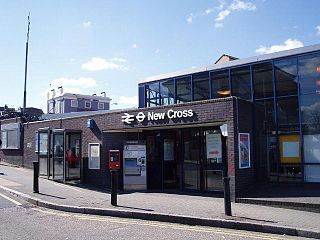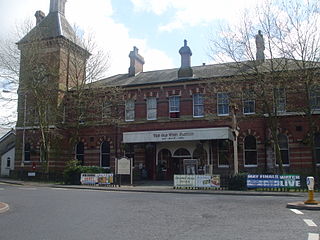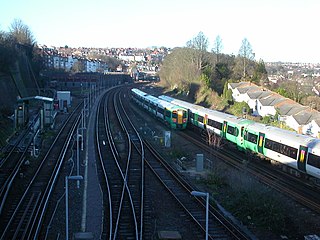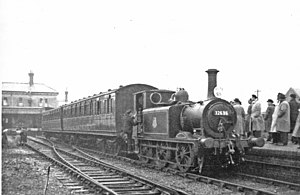
New Cross railway station serves New Cross in south-east London, England. It is 4 miles 68 chains (7.8 km) down the line from London Charing Cross and is in London fare zone 2. The platforms are lettered rather than numbered to avoid confusion with those at New Cross Gate by staff who worked at both stations before privatisation of the stations in 1997. Platform D is used exclusively by London Overground services. Ticket barriers control access to all platforms.

The London, Brighton and South Coast Railway was a railway company in the United Kingdom from 1846 to 1922. Its territory formed a rough triangle, with London at its apex, practically the whole coastline of Sussex as its base, and a large part of Surrey. It was bounded on its western side by the London and South Western Railway (L&SWR), which provided an alternative route to Portsmouth. On its eastern side the LB&SCR was bounded by the South Eastern Railway (SER)—later one component of the South Eastern and Chatham Railway (SE&CR)—which provided an alternative route to Bexhill, St Leonards-on-Sea, and Hastings. The LB&SCR had the most direct routes from London to the south coast seaside resorts of Brighton, Eastbourne, Worthing, Littlehampton and Bognor Regis, and to the ports of Newhaven and Shoreham-by-Sea. It served the inland towns and cities of Chichester, Horsham, East Grinstead and Lewes, and jointly served Croydon, Tunbridge Wells, Dorking and Guildford. At the London end was a complicated suburban and outer-suburban network of lines emanating from London Bridge and Victoria, and shared interests in two cross-London lines.

Brighton railway station is the southern terminus of the Brighton Main Line, the western terminus of the East Coastway Line and the eastern terminus of the West Coastway Line in England, and the principal station serving the city of Brighton, East Sussex. It is 50 miles 49 chains from London Bridge via Redhill.

The East Coastway line is a railway line along the south coast of Sussex to the east of Brighton, England. Trains to the west of Brighton operate on the West Coastway line. Together with the West Coastway and the Marshlink line to the east, the line forms part of a continuous route from Havant to Ashford. The Brighton Main Line route to Eastbourne and Hastings, via Plumpton and Cooksbridge, shares the East Coastway line east of Lewes station.

Lewes railway station serves the town of Lewes in East Sussex, England. It has five platforms and is on the East Coastway Line, 49 miles 74 chains (80.3 km) from London Bridge via Redhill. Train services are provided by Southern.

Eastbourne railway station serves the seaside town of Eastbourne in East Sussex, England. It is on the East Coastway Line. The station is managed by Southern, who operate all trains serving it. It is one of two railway stations in the town, the other being Hampden Park Station. There are also two other stations in the Eastbourne area, one being Pevensey & Westham, in nearby Westham, the other being Polegate.

Haywards Heath railway station is on the Brighton Main Line in England, serving the town of Haywards Heath, West Sussex. It is 37 miles 59 chains (60.7 km) down the line from London Bridge via Redhill and is situated between Balcombe and Wivelsfield. It is managed by Southern.

Littlehampton railway station is in Littlehampton in the county of West Sussex, England. The station and the trains serving it are operated by Southern.

New Brighton railway station serves the suburb of New Brighton in Wallasey Merseyside, England. It is situated at the end of the New Brighton branch of the Wirral Line 8.25 miles (13.28 km) west of Liverpool Lime Street on the Merseyrail network.

Birkenhead North railway station serves the town of Birkenhead, in Merseyside, England. The station is situated on the Wirral Line of the Merseyrail network, close to the junction of the New Brighton and West Kirby branches. Birkenhead North TMD, situated just to the west of the station, is the main traction maintenance depot for the Merseyrail fleet.

The Stourbridge Town branch line is a 0.8-mile (1.3 km) railway branch line, in Stourbridge, West Midlands, England. It is the shortest line in Britain, and can also be defined as the shortest line in Europe.

Tunbridge Wells West is a railway station located in Royal Tunbridge Wells, Kent. It is one of two railway stations in Tunbridge Wells constructed by rival companies. The other, Tunbridge Wells Central was opened in 1845 by the South Eastern Railway (SER). Tunbridge Wells West was closed to mainline passenger services in 1985, but part of it still remains as a heritage railway line. Opened in 1996, it stands next to the original engine shed. The line is called the Spa Valley Railway.

Birkenhead Town railway station is a disused railway station in Birkenhead, Wirral, England. It was located near the current entrance to the Queensway Tunnel on Grange Road.

Public transport in Brighton and Hove, a city on the south coast of England, dates back to 1840. Brighton and Hove has a major railway station, an extensive bus service, many taxis, coach services, and it has previously had trolley buses, ferries, trams, auto rickshaws and hydrofoils.
The Preston and Longridge Railway (P&LR) was a branch line in Lancashire, England. Originally designed to carry quarried stone in horse-drawn wagons, it became part of an ambitious plan to link the Lancashire coast to the heart of Yorkshire. The ambition was never achieved, but the line continued to carry passengers until 1930 and goods until 1967.
Lewes Road railway station was a railway station in Brighton, East Sussex. It was located on the now closed Kemp Town branch line which first opened in 1869. The station opened on 1 September 1873 and was closed to passengers in 1933 but the line remained opened for goods trains until 1971.

Hartington Road Halt railway station was a stop on the Kemp Town branch railway line between Brighton station and Kemp Town, Brighton, East Sussex. It was open only briefly between 1906 and 1911. The line it stood on was closed permanently in 1971 and has now been demolished.

Fairford railway station served the town of Fairford in Gloucestershire. It was the western terminus of the Oxford, Witney and Fairford Railway between Oxford and Fairford. It had one platform, and a stone-built station building.
Kemp Town branch line was a railway line running from Brighton to Kemptown in the UK that operated between 1869 and 1971. It ran from a junction off the Brighton to Lewes line between London Road and Moulsecoomb stations, to Kemp Town railway station. It opened in 1869 and was expensive to construct, requiring a tunnel and a large viaduct.


















